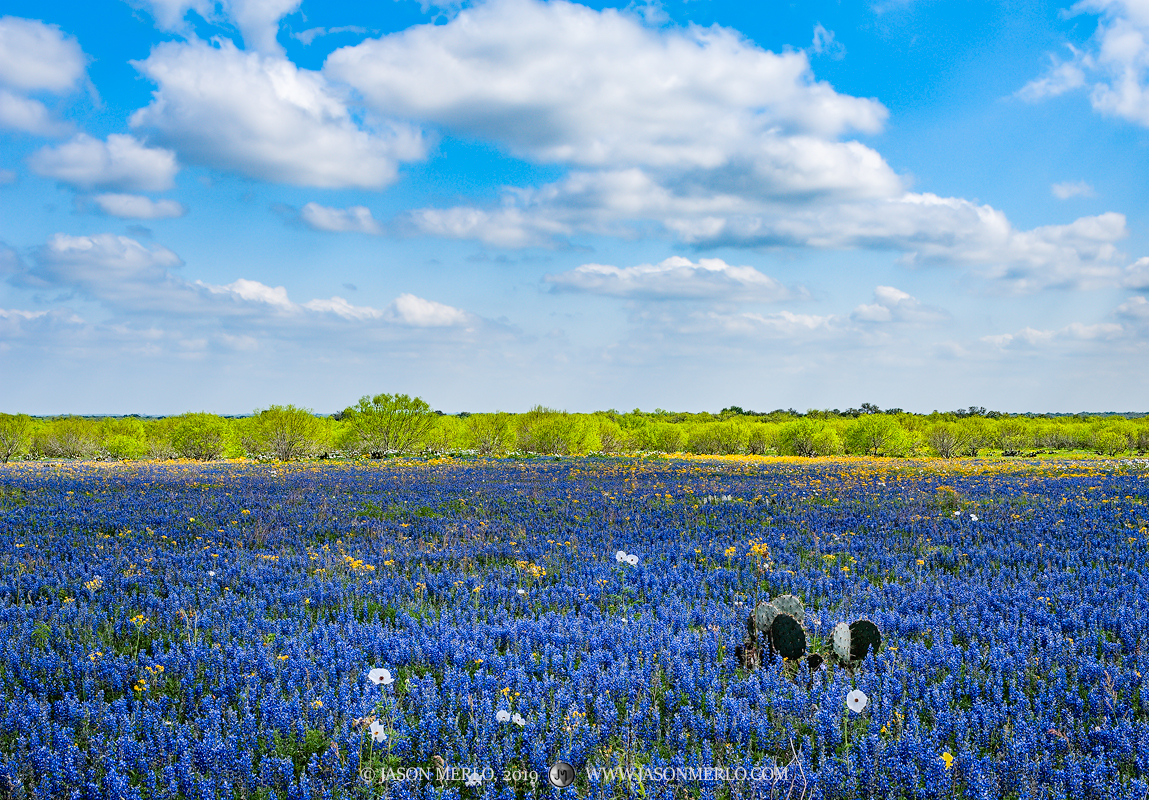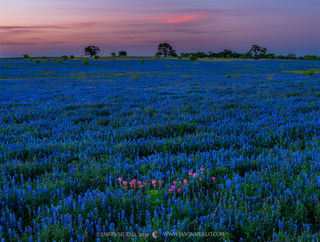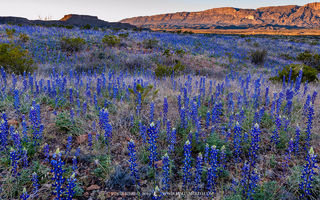Bluebonnet Notes: Contributing Factors For A Bluebonnet Bloom (Part I)
Each year in the months approaching the bluebonnet season, I find my thoughts turning to what the upcoming bloom holds in store without having to guess about what the wildflowers would look like based on how much rain I can remember falling during the previous fall and winter. Therefore, an analysis of the factors which contribute to the success of a bluebonnet season is in order so that we can attempt to identify weather patterns that are predictive of a good bloom.
In an effort to keep this as readable as possible I will break this analysis down into a four-part series. The first part will be a general discussion about bluebonnet seed, weather, and other factors which combine to create a bluebonnet bloom. Parts two through four will be a look back at the rainfall and temperature data from three regions of Texas: Big Bend in West Texas, South Texas, and the Texas Hill Country.
Bluebonnet life cycle
The bluebonnet’s life cycle can be separated into three parts: seed germination, rosette development, and bloom. When each of these phases begins and then transitions to the next phase is dependent on several things, including the species of bluebonnet, the region of Texas in which it grows, the amount and timing of rainfall, and temperatures. Germination requires warm temperatures, and can occur as early as September and as late as November. Rosette development takes place during the cooler months, from November/December to February/March, during which the plants develop their root systems. In February/March, as temperature begin to warm up again, the rosettes become blooming bluebonnets.
Bloom factors
Before a bloom can take place many things have to come together. First, there has to be viable seed present on the ground. Every year after bluebonnets are pollinated the blooms form seed pods, with each pod containing between five to ten seeds. Eventually the pods burst and scatter the seed in a radius of up to several feet from the plant. The seeds look like very small pebbles, camouflaged in order to prevent birds from finding and eating them. The scatter and the camouflage are mechanisms employed by the bluebonnet to ensure the species’ survival.
Another of the bluebonnet’s survival mechanisms is its seeds’ extremely durable outer coating. This coating takes time to wear away before the seed can germinate, which means that only a small percentage of bluebonnet seed on the ground will germinate in a given year. How long does it take for a seed’s outer coating to become permeable enough to allow germination? It most likely varies from seed to seed. Although research on this topic seems to be either extremely limited or non-existent, I do have an idea about how long the seed can last out in the elements based on personal knowledge of the amount of time between blooms I have seen in the same place, and that is at least twelve years (2007 to 2019). To clarify, this means that I saw bluebonnets bloom in a certain place in 2007 and then not bloom again in the same place until 2019. Can bluebonnet seed remain viable for longer than twelve years? Probably. Does all bluebonnet seed remain viable for at least twelve years? Probably not.
The answer to this question could also be an indicator of when a great bloom might occur. For example, the 2010 bluebonnet season in the Texas Hill Country was an outstanding bloom, and certainly produced an enormous amount of seed. If the seed, on average, required five years out in the weather for its outer coating to become permeable enough to allow germination one could predict that, assuming optimal environmental conditions, the 2016 bluebonnet season would be an outstanding bloom as well.

A field of sandyland bluebonnets (Lupinus subcarnosus) and mesquite (Prosopis glandulosa) under cumulus clouds near Poteet in Atascosa County in South Texas. Prints and licensing available.
In addition to viable seed being present, the correct environmental conditions must exist in order for the bluebonnet to develop. Environmental conditions such as rainfall amount, rainfall timing, and temperature not only affect whether a bluebonnet will bloom, but how many blooms each plant will have and how long the blooms will last. Assuming germination occurred, favorable weather conditions can result in a bushy, full plant with eight to ten tall-spiked blooms (known as racemes) that lasts for several weeks, while poor conditions can result in a single short bloom on a dry, stunted plant that doesn’t last very long at all.
We know that seeds can germinate as early as September and as late as November and that warm weather is optimum for such. What exactly does warm mean? One study (Mackay, et al 1996) found that germination occurred most rapidly between 75 and 85 degrees Fahrenheit using Lupinus perennis seed from Wisconsin which was scarified (treated chemically to increase the seed coating's permeability). While Lupinus perennis, commonly known as perennial lupine or sundial lupine, does occur in the Big Thicket and other areas in East Texas, the applicability of this study to wild seed from the more prolific species of bluebonnets in Texas is questionable.
We also know that after germination, from November/December to February/March, cold weather is needed for rosettes to develop robust root systems through a process called vernalization. Vernalization is the induction of a plant's flowering process by exposure to the prolonged cold of winter, or by an artificial equivalent. After vernalization, plants have acquired the ability to flower, but they may require additional seasonal cues or weeks of growth before they will actually flower. These cues could include certain amounts of rainfall, rising temperatures, and/or nutrient uptake by the bluebonnet.
Obviously, rainfall is needed for both germination and during seed development, but how much, and when? Too little rainfall is certainly possible, but is too much rainfall also possible? These, too, are questions which do not appear to have been formally researched by academia.
Related to environmental conditions, and often overlooked, is the need for rhizobium in the soil. Rhizobia are bacteria that fix nitrogen after becoming established inside the root nodules of legumes, of which the bluebonnet is one. Essentially, they act as a fertilizer for bluebonnets by pulling nitrogen from the air and converting it into a form that the bluebonnet can use. According to Zahran (1999) "a competitive and persistent rhizobial strain is not expected to express its full capacity for nitrogen fixation if limiting factors (e.g., salinity, unfavorable soil pH, nutrient deficiency, mineral toxicity, temperature extremes, insufficient or excessive soil moisture, inadequate photosynthesis, plant diseases, and grazing) impose limitations on the vigor of the host legume." (p. 970). What this means is that something like drought, or excessive rain, or extreme temperatures in either direction can affect rhizobium's ability to make fertilizer for bluebonnets. There is more to this but it goes beyond the scope of this review.
Along the same line as rhizobium is mycorrhiza, which are fungi that are able to form a symbiotic relationship with bluebonnets and other legumes for the purpose of increasing the plant's uptake of water and nutrients. Again, it is an advanced topic that is beyond the scope of this review.
Other things such as how much grass or other competing vegetation is present where bluebonnet seed lies have the potential to negatively affect a bloom. Bluebonnets love open sun, and any type of cover around them as they are developing has the potential to be detrimental. They also prefer well-drained soil, and in the event that bluebonnet seeds have scattered into an area that holds water after a rain due to topography or soil type it would have a significantly decreased chance of developing into a blooming plant.
Certain factors during a bloom can also have a detrimental effect, such as the presence/density of cattle in fields where they grow. Cattle can walk large trails through fields of bluebonnets, and large patches of flowers can be crushed if cattle choose to bed down among them. Cattle may also inadvertently eat blooms while grazing, though this is usually not a concern.
Predicting a bloom
Due the number and complexity of all the factors involved, it is nearly impossible to predict with any certainty how good a year's bloom will be. We can’t know how much viable seed is present on any given piece of ground, we don't know for certain what the optimum temperature and rainfall are, and we can't evaluate the presence or absence of rhizobium or mycorrhiza. We can, though, analyze weather data from September to February/March to try to form an idea about whether an upcoming year might be a successful bloom, and where the best bloom might occur.
The amount of available research in this area is very limited and focused on seed that has been scarified either manually or chemically, so in order to attempt to determine what an optimum temperature and level of rainfall are we must look at temperature and rainfall histories and cross check them against what we actually saw on the ground during a past year’s bloom. In doing so we might be able to discern what are some favorable combinations of environmental conditions that will allow us to predict an upcoming year's bloom as accurately as possible. To do that we will examine data from past bluebonnet seasons in the Big Bend, South Texas, and the Texas Hill Country. This will give us a look at the three most prolific species of bluebonnets in Texas: Texas bluebonnets (Lupinus texensis), sandyland bluebonnets (Lupinus subcarnosus), and Big Bend bluebonnets (Lupinus havardii). These three areas are certainly not the only areas in the state where bluebonnets bloom, but they are the areas with which I am most familiar.
In Part II of this series, we will look at the 2016 and 2019 bluebonnet seasons in the Big Bend of Texas. Stay tuned...
Sources
Barea, J. M., Azcon-Aguilar, C., & Azcon, R. (1988). The Role of Mycorrhiza in Improving the Establishment and Function of the Rhizobium-Legume System under Field Conditions. Nitrogen Fixation by Legumes in Mediterranean Agriculture, 153–162. doi: 10.1007/978-94-009-1387-5_17
Mackay, W. A., Davis, T. D., Sankhla, D., & Riemenschneider, D. E. (1996). Factors Influencing Seed Germination of Lupinus perennis. Journal of Environmental Horticulture, 14(4), 167–169.
Olivieri, R. (2019). Recipe for an Awesome Wildflower Season: Comparison of Wildflower Season Factors for Mason County from 1997 to 2018. Retrieved from http://www.wildflowerhaven.com/Portals/6/MasonCounty-ComparisonOfWildflowerFactors-1997-2018.pdf.
Parsons, J. M., George, S., & Grant, G. (n.d.). Texas Bluebonnets - Texas Pride. Retrieved from https://aggie-horticulture.tamu.edu/archives/parsons/flowers/bluebonnet/bluebonnetstory.html.
Parsons, J. (n.d.). PlantAnswers. Retrieved from https://aggie-horticulture.tamu.edu/parsons/search.php?category=Bluebonnet%20Seeds
Vernalization. (2019, December 17). Retrieved from https://en.wikipedia.org/wiki/Vernalization
Zahran, H. H. (1999). Rhizobium-Legume Symbiosis and Nitrogen Fixation under Severe Conditions and in an Arid Climate. Microbiology and Molecular Biology Reviews, 63(4), 968–989. doi: 10.1128/mmbr.63.4.968-989.1999



